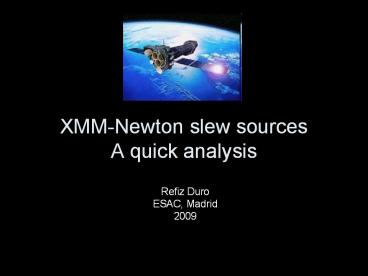XMM-Newton slew sources A quick analysis - PowerPoint PPT Presentation
1 / 8
Title:
XMM-Newton slew sources A quick analysis
Description:
Median exposure time: ~6.2 seconds (min ~ 1s, max~12s) Images roughly 1 degree by 0.5 degree ... eslewchain (create images, exposure maps) emask (area for ... – PowerPoint PPT presentation
Number of Views:39
Avg rating:3.0/5.0
Title: XMM-Newton slew sources A quick analysis
1
XMM-Newton slew sourcesA quick analysis
- Refiz Duro
- ESAC, Madrid
- 2009
2
Aims
- Find new variable sources
- Quick, automatic analysis of slew data with
results provided to the user
3
Agenda
- XMM-Newton slew data description
- Comparison to ROSAT data
- Results
- Conclusion
4
Slew data
- Slews images taken while the telescope is
changing its position from one pointed
observation to the next - Slew speed of 90 deg/hour
- EPIC-pn data
- Shallow survey of the sky. Image properties
- 0.2 2.0 keV (soft energy band)
- Median exposure time 6.2 seconds (min 1s,
max12s) - Images roughly 1 degree by 0.5 degree
5
Source searching
- SAS (Science Analysis Software) tasks
- eslewchain (create images, exposure maps)
- emask (area for source searching)
- eboxdetect (source searching)
- esplinemap (constructs background map)
- emldetect (info on the sources)
- Tables with the sources and their properties
- More details in Saxton et al. 2008
6
Comparison to ROSAT
- Aim find variable sources
- ROSAT X-ray all sky survey (RASS) (done in
1991/92) soft X-ray 0.2-2.4 keV - Bright, faint point source catalogues
- Expected factor of difference between XMM-Newton
and ROSAT fluxes for a non-variable source is 6.4
(Spectral model of an absorbed power-law with
slope 2.4 and NH31020cm(-2)) - Larger/smaller factors suggest a variable source
7
Results
- Table 1 XMM-Newton sources compared to ROSAT
source counterparts. - Table 2 Upper limits table. Sources which were
expected to be found in the slew images based on
the coordinates from RASS, but which were not
detected in the analysis.
8
Conclusion
- Quickly analyzed X-ray slew data
- Results presented on the web
- New variable sources































